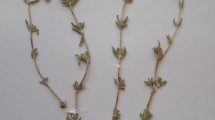Abstract
Celery-based products were investigated for chemical composition, skin irritation, and mosquito repellency in comparison to commercial repellents and the standard chemical, N,N-diethyl-3-methylbenzamide (DEET), with a goal to develop a natural alternative to synthetic repellents for protection against mosquitoes. Chemical identification by gas chromatography coupled with mass spectrometry discovered that the major constituents of Apium graveolens hexane extract (AHE) were 3-n-butyl-tetrahydrophthalide (92.48%), followed by 5.10% β-selinene and 0.68% γ-selinene. Evaluation of skin irritation in 27 human volunteers revealed no irritant potential from 25% ethanolic AHE solution. Laboratory investigated repellent against female Aedes aegypti mosquitoes demonstrated that G10 formula, the best AHE-developed product, provided remarkable repellency with a median protection time of 4.5 h (4.5–5 h), which was greater than that of ethanolic DEET solution (25% DEET, 3.5 h) and comparable to that of the best commercial repellent, Insect Block 28 (28.5% DEET, 4.5 h). According to significantly promising results, including highly effective repellency and no potential skin irritation or other side effects, the G10 formula is a worthwhile product that has the promise of being developed for commercialized registration. This developed AHE product could be an acceptable and affordable alternative to conventional synthetic chemicals in preventing mosquito bites, and in turn, helping to interrupt mosquito-borne disease transmission.
Similar content being viewed by others
References
Basketter DA, Chamberlain M, Griffiths HA, Rowson M, Whittle E, York M (1997) The classification of skin irritants by human patch test. Food Chem Toxicol 35:845–852
Bisset NG (1994) Herbal drugs and phytopharmaceuticals: a handbook for practice on a scientific basis. Medpharm Scientific Publishers, Stuttgart
Curtis T, Williams DG (1994) Aromatic materials. I. Aroma chemicals. In: Curtis T, Williams DG (eds) Introduction to Perfumery. Ellis Harwood, UK, pp 140–213
Fradin MS, Day JF (2002) Comparative efficacy of insect repellents against mosquito bites. N Engl J Med 347:13–18
Frances SP, Wirtz RA (2005) Repellents: past, present, and future. J Am Mosq Control Assoc 21:1–3
Isman MB (2000) Plant essential oils for pest and disease management. Crop Prot 19:603–608
Kamsuk K, Choochote W, Chaithong U, Jitpakdi A, Tippawangkosol P, Riyong D, Pitasawat B (2007) Effectiveness of Zanthoxylum piperitum-derived essential oil as an alternative repellent under laboratory and field applications. Parasitol Res 100:339–345
Kitajima J, Ishikawa T, Satoh M (2003) Polar constituents of celery seed. Phytochemistry 64:1003–1011
Limsuwan S, Rongsriyam Y, Kerdpibule V, Apiwathnasorn C, Chiang GL, Cheong WH (1987) Rearing techniques for mosquitoes. In: Sucharit S, Supavej S (eds) Practical entomology. Malaria and filariasis, 1st edn. Museum and Reference Centre, Faculty of Tropical Medicine, Mahidol University, Bangkok, Thailand
Lust JB (1974) The herb book. Benedict Lust Publications, California
Novak RJ, Gerberg EJ (2005) Natural-based repellent products: efficacy for military and general public uses. J Am Mosq Control Assoc 21(Suppl 4):7–11
Palumbo JF, Lynn EV (1953) Dermatitis from celery. J Am Mosq Control Assoc 42:57
Pauli G, Bessot JC, Dietmann-Molard A, Braun PA, Thierry R (1985) Celery sensitivity: clinical and immunological correlations with pollen allergy. Clin Allergy 15:273–279
Qiu H, Jun HW, John WM (1998) Pharmacokinetic, formulation, and safety of insect repellent N,N-diethyl-3-methylbenzamide (DEET): a review. J Am Mosq Control Assoc 14:12–27
Rafikali AM, Muraleednaran GN (2001) Mosquitocidal, nematocidal and antifungal compounds from Apium graveolens L. seeds. J Agric Food Chem 49:142–145
Rafikali AM, Russel SR, Muraleednaran GN (2000) Bioactive compounds and 1,3-Di [(cis)-9-octadecenoyl]-2-[(cis,cis)-9–12-octadecadienoyl] glycerol from Apium graveolens L. seeds. J Agric Food Chem 48:3785–3788
Rozendaal JA (1997) Vector control: methods for use by individuals and communities. World Health Organization, Geneva, pp 7–177
Tawatsin A, Wratten SD, Scott RR, Thavara U, Techadamrongsin Y (2001) Repellency of volatile oils from plants against three mosquito vectors. J Vector Ecol 26:76–82
Traboulsi AF, EL-Haj S, Tueni M, Taoubi K, Nader NA, Mrad A (2005) Repellency and toxicity of aromatic plant extracts against the mosquito Culex pipiens molestus (Diptera: Culicidae). Pest Manag Sci 61:597–604
Trongtokit Y, Curtis CF, Rongsriyam Y (2005a) Efficacy of repellent products against caged and free flying Anopheles stephensi mosquitoes. Southeast Asian J Trop Med Public Health 36:1423–1431
Trongtokit Y, Rongsriyam Y, Komalamisra N, Apiwathnasorn C (2005b) Comparative repellency of 38 essential oils against mosquito bites. Phytother Res 19:303–309
Trongtokit Y, Rongsriyam Y, Komalamisra N, Krisadaphong P, Apiwathnasorn C (2004) Laboratory and field trial of developing medicinal local Thai plant products against four species of mosquito vectors. Southeast Asian J Trop Med Public Health 35:325–333
Tuetun B, Choochote W, Kanjanapothi D, Rattanachanpichai E, Chaithong U, Chaiwong P, Jitpakdi A, Tippawangkosol P, Riyong D, Pitasawat B (2005) Repellent properties of celery, Apium graveolens L., compared with commercial repellents, against mosquitoes under laboratory and field conditions. Trop Med Int Health 10:1190–1198
Tuetun B, Choochote W, Rattanachanpichai E, Chaithong U, Jitpakdi A, Tippawangkosol P, Riyong D, Pitasawat B (2004) Mosquito repellency of the seeds of celery (Apium graveolens L. Ann Trop Med Parasitol 98:407–417
WHO (1996) Report of the WHO informal consultation on the evaluation and testing of insecticides. CTD/WHOPES/IC/96.1, Control of Tropical Diseases Division. WHO, Geneva
Yang P, Ma Y (2005) Repellent effect of plant essential oils against Aedes albopictus. J Vector Ecol 30:231–234
Yang Y-C, Lee H-S, Lee SH, Clark JM, Ahn Y-J (2005) Ovicidal and adulticidal activities of Cinnamomum zeylanicum bark essential oil compounds and related compounds against Pediculus humanus capitis (Anoplura: Pediculicidae). Int J Parasitol 35:1595–1600
Acknowledgment
The authors are grateful to the individuals who served as subject volunteers. Financial support from the Thailand Research Fund through the Royal Golden Jubilee Ph.D. Program (grant no. PHD/0112/2547) and the Faculty of Medicine Research Fund, Faculty of Medicine, Chiang Mai University, Thailand, is gratefully acknowledged.
Conflicts of interest statement
The authors have no conflicts of interest regarding this article.
Author information
Authors and Affiliations
Corresponding author
Rights and permissions
About this article
Cite this article
Tuetun, B., Choochote, W., Pongpaibul, Y. et al. Celery-based topical repellents as a potential natural alternative for personal protection against mosquitoes. Parasitol Res 104, 107–115 (2008). https://doi.org/10.1007/s00436-008-1167-1
Received:
Accepted:
Published:
Issue Date:
DOI: https://doi.org/10.1007/s00436-008-1167-1




